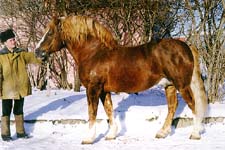Russian Heavy Draft
N/A
Sun, 20th April, 2025 - 6:05 pm GMT
Sponsor Ads:

Alternative Name
N/ABasic Info
The Russian Heavy Draft Horse is short and muscular in appearance, with a thick mane and tail and lightly feathered legs. The breed is distinguished by its short legs relative to its body length, a conformation that provides excellent traction, especially when pulling weight. The neck is thick and well crested Relative to most other draft breeds, the Russian Heavy Draft Horse reaches physical maturity at an early age. By 18 months, the horse typically reaches 95% of its adult height and 75% of its mature weight. By age three, it is fully-grown. Average measurements for breeding stallions are 150 centimeters at the withers, 158 cm. in body length (measured diagonally from the shoulder to the hip, a line with a slight declination to the rear), 193 cm. at the birth or barrel, and 22 cm. circumference at the cannon bone. Or, expressed in the shorthand familiar to Russian horsemen, 150-158-193-22.
Health
N/AHabitat
N/ABehavior
Docile in temperament, agile and energetic even in rough terrain, an easy keeper, tolerant of cold, the Russian Heavy Draft Horse offers the best traits of a draft horse in a compact packageOrigin
RussiaHistory
Officially registered only in 1952, the Russian Heavy Draft Horse began its evolution toward the status of a distinct breed in the late nineteenth century. At that time locally-bred peasant horses, essential for agricultural work, were systematically improved by crossing sturdy grade Russian mares with well-established warm-blood and draft horses: the Orlov Trotter, Percheron, and primarily Ardennes breeds. This last breed, the (Belgian) Ardennes, was introduced into Russia in the mid-1880s; its influence is still evident in the conformation and temperament of the Russian Heavy Draft. The Russian Heavy Draft Horse has had a significant, but largely unrecorded, influence on improving agricultural stock. Many horses that can still be seen pulling carts in the countryside outside of major cities carry Russian Heavy Draft blood. The breed is noted for its milk-producing capacities. Fermented mare’s milk (in Russian kumys) has enjoyed a long tradition as a medicinal tonic in southern Russia and the steppes of Central Asia. Kumys is mentioned in the work of the literary giants of the nineteenth century, including Alexander Pushkin, Mikhail Lermontov and Leo Tolstoy. Tolstoy regularly drank the beverage during the summers that he spent on his farm in Samara. The fermented milk was thought to stimulate the appetite, improve digestion, and increase immunity to disease, and was recommended for such varied conditions as gastritis, anemia, tuberculosis and impotence. The Russian Heavy Draft Horse is the breed of choice at an experimental farm for the production of kumys located in Ryazan, at the All-Union Institute for Horsebreeding.Common Foods
grassSponsor Ads:
"For ever and a day". As You Like It Act IV, Sc. I, William Shakespeare
Russian Heavy Draft
Coded by: BGID® | ALL RIGHTS RESERVED Copyright © 2000-2025
Disclaimer | Privacy | Report Errors / Contact | Credits








 Preparing For China. China is growing their military. China Military Technology - can it keep up with the US?
Preparing For China. China is growing their military. China Military Technology - can it keep up with the US?  versus
versus 

 versus
versus 
 This Thread is about the North Korean Military itself - the kind of army, navy, and air force they have.
This Thread is about the North Korean Military itself - the kind of army, navy, and air force they have. 
 versus
versus 
 versus
versus  versus
versus